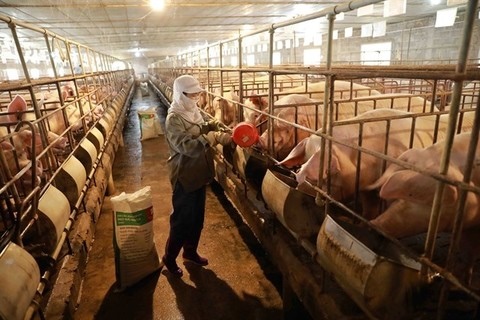Large livestock businesses are likely to benefit from new regulations
Large livestock businesses are likely to benefit from new regulations
Large livestock enterprises are expected to benefit greatly when the regulation on locations not permitted to run livestock farms takes effect from 2025.

A pig farm. Tens of thousands of livestock facilities nationwide will have to move out of residential areas or cease operations. — VNA/VNS Photo Vũ Sinh |
But it's feared the same regulation will cause problems for small households running pig farms.
The Law on Livestock that was effective from 2020 has an article on prohibiting to conduct livestock production in areas not allowed for livestock production in cities, towns and living quarters; except raising ornamental animals and raising animals in the laboratory without polluting the environment.
According to the law, that regulation will come into effect from January 1, 2025. with localities given five years to relocate unsuitable livestock facilities.
Tens of thousands of livestock facilities nationwide will have to move out of residential areas or cease operations. This is considered a great change of the livestock sector.
According to analysts, the new regulation will force small livestock farms to leave, making way for large-scale facilities. This is also an inevitable trend for the livestock industry to be standardised.
According to the January 2024 report released by Agribank Securities Joint Stock Company (Agriseco), many livestock households will have to stop their production. The Ministry of Agriculture and Rural Development has a draft to support those livestock households in the relocation of their farms. But, up to now it has not been approved.
With this change, large listed enterprises of the livestock industry have actively invested in expansion to increase capacity.
Notably, Dabaco Vietnam Group Joint Stock Company (stock code: DBC) and BaF Vietnam Agriculture Joint Stock Company (stock code: BAF) have invested in a series of new livestock farms to increase capacity.
Dabaco has invested in increasing capacity with a series of large-scale livestock farm projects. They include a livestock project with capacity of 5,600 sows and 77,400 commercial pigs in Thanh Hóa, and Dabaco Phú Thọ pig breed project's Phase 3 with a capacity of 4,800 sows and more than 70,000 commercial pigs. The total capacity of the two projects increases by nearly 25 per cent.
The large businesses also have an advantage of having food supply chain from farm to table, being less affected by diseases than the supply from livestock households, thanks to ensuring hygiene and safety in production.
In addition, the large businesses will not sell off due to having the disease, reducing price fluctuations in the market.
According to experts, to have stable development in the livestock industry, localities need to actively implement the Livestock Law and livestock development strategies. They need to focus on developing a market-oriented livestock industry, promoting the strengths of each region and each key livestock to improve production efficiency.
They should also promote a high-tech livestock industry, develop key products associated with brand construction and development, and continuously expand livestock production applying VietGAP standards.
In the Livestock Development Strategy until 2030, Việt Nam strives to have a total pig herd of 30 million, produce about 6 million tonnes of meat (pork accounting for 60 per cent), and export 15-20 per cent of pork output total.
In 2024, the livestock industry aims to increase production value by about 4-5 per cent compared to 2023, and the proportion of livestock in the overall agricultural production is estimated to reach 28-30 per cent.























